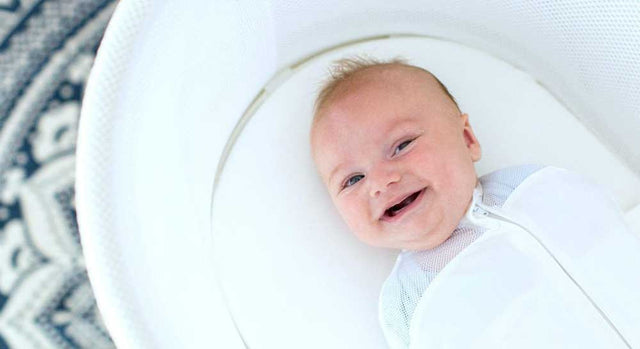8 Tips to Help Your Baby Get Used to SNOO

Babies are individuals. Some are timid, some outgoing, some sensitive, and others are "surfer dudes," unfazed by the bustle around them.
Likewise, for soothing and sleep…some need sucking, some white noise, some jiggling, and others need all 5 S’s (vigorously!) to calm.
So, if your infant doesn’t instantly quiet in SNOO, try our tips:
Be patient with “older babies.”
If your little one is over 6 to 8 weeks old, they may need 4 to 5 days to get used to the new motion and sound. The more your baby sleeps in SNOO (naps and nights), the sooner it should comfort them.
Put your baby down…asleep.
We’ve learned that babies who are used to contact napping need time to adjust. Got a hunch that’s your situation? Try this: When it’s almost bed or naptime, zip your baby in their SNOO Sack, feed them well and offer a pacifier (if they like it) and rock your little one into a deep sleep. Then, gently transfer your baby to SNOO. Use the Happiest Baby App to set the motion on a low level, purple, or blue. After four to five days of naps/nights in SNOO, your baby's new surroundings should begin feeling familiar.
Build happy SNOO memories.
Start planning three to four fun times in SNOO each day. For example, give a delicious baby massage in there—then take your bub out for a cuddle. Loving touch can help babies associate good vibes with SNOO!
Learn the cues.
SNOO won’t calm fussing when your baby needs YOU! Check if your nugget is hungry, hot, cold, or needs a new diaper. Once you meet your baby's needs, they'll likely soothe and snooze. (If your baby continues to fuss no matter what you do, check with your doctor.)
Trust yourself.
SNOO can usually calm a baby within a minute. So, if by 60 seconds your gut tells you SNOO isn’t doing the trick…take your baby out, soothe themm and then lay your bub down again calm. (By the way, SNOO automatically turns off if any crying lasts over three minutes! But, you never need to wait that long if it doesn’t feel right.)
Swaddle with the arms down.
Snug wrapping in a swaddle helps babies settle faster. But if your wiggly worm gets an arm loose inside their SNOO Sack, that’s your cue to tighten the inner band. Also, ensure the bottom of the inner band covers part of your baby's hand. Most babies sleep better arms down for at least three to four months. (FYI, our SNOO Sack has snap openings at the shoulders for babies’ arms to be free.)
Help your baby learn day from night.
Families tell us that their babies woke more at night if they took long daytime naps (and didn’t eat enough). So, it’s good to keep naps to under two hours. You’ll get more calories in and reduce night waking from hunger.
Try food, louder white noise, or a paci.
Some babies need up to two extra feedings to be ready to sleep…even if they just ate! And most babies need it noisy to calm down. So, you might run a cool hair dryer 6 inches away for a few minutes, if SNOO just isn’t soothing your little one. Or, offer a pacifier to see if that solves the mystery! (If you’re nursing, it’s best to wait until your baby is sucking well before using pacifiers or bottles.) Bonus: Falling asleep with a paci is shown to help lower a baby’s risk for SIDS!